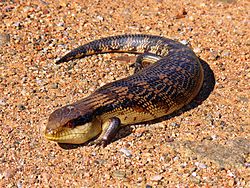
Vertebrate
About this schools Wikipedia selection
SOS Children offer a complete download of this selection for schools for use on schools intranets. SOS Children has looked after children in Africa for forty years. Can you help their work in Africa?
| Vertebrates Temporal range: Early Cambrian - Recent |
|
|---|---|
 |
|
| Blotched Blue-tongued Lizard, Tiliqua nigrolutea | |
| Scientific classification | |
| Kingdom: | Animalia |
| Phylum: | Chordata |
| (Unranked) | Craniata |
| Subphylum: | Vertebrata Cuvier, 1812 |
| Classes and Clades | |
|
See below |
|
Vertebrates are members of the subphylum Vertebrata, chordates with backbones or spinal columns. The grouping sometimes includes the hagfish, which have no vertebrae, but are genetically quite closely related to lampreys, which do have vertebrae. For this reason, the sub-phylum is sometimes referred to as "Craniata", as all members do possess a cranium. About 58,000 species of vertebrates have been described. Vertebrata is the largest subphylum of chordates, and contains many familiar groups of large land animals. Vertebrates comprise cyclostomes, bony fish, sharks and rays, amphibians, reptiles, mammals, and birds. Extant vertebrates range in size from the carp species Paedocypris, at as little as 7.9 mm (0.3 inch), to the Blue Whale, at up to 33 m (110 ft).
Anatomy and morphology
One characteristic of the subphylum are that all members have muscular systems that mostly consist of paired masses, as well as a central nervous system which is partly located inside the backbone (if one is present). The defining characteristic of a vertebrate is considered the backbone or spinal cord, a brain case, and an internal skeleton, but the latter do not hold true for lampreys, and the former is arguably present in some other chordates. Rather, all vertebrates are most easily distinguished from all other chordates by having a clearly identifiable head, that is, sensory organs - especially eyes are concentrated at the fore end of the body and there is pronounced cephalization. Compare the lancelets which have a mouth but not a well-developed head, and have light-sensitive areas along their entire back.
Evolutionary history
Vertebrates originated about 500 million years ago during the Cambrian explosion, which is part of the Cambrian period. The earliest known vertebrate is Myllokunmingia. According to recent molecular analysis Myxini (hagfish) also belong to Vertebrates. Others consider them a sister group of Vertebrates in the common taxon of Craniata.
Fossil record
The earliest known fossil records of vertebrates are Myllokunmingia fengjiaoa and Haikouichthys ercaicunensis, dating somewhere between 513-542 mya during the Early Cambrian. The fossils were discovered in Yunnan, China .
Taxonomy and classification
Classification after Janvier (1981, 1997), Shu et al. (2003), and Benton (2004).
- Subphylum Vertebrata
- (Unranked group) Hyperoartia ( lampreys)
- Class † Conodonta
- Subclass † Pteraspidomorphi
- Class † Thelodonti
- Class † Anaspida
- Class † Galeaspida
- Class † Pituriaspida
- Class † Osteostraci
- Infraphylum Gnathostomata (jawed vertebrates)
-
-
-
- Class † Placodermi (Paleozoic armoured forms)
- Class Chondrichthyes (cartilaginous fish)
- Class † Acanthodii (Paleozoic "spiny sharks")
- Superclass Osteichthyes (bony fish)
-
- Class Actinopterygii (ray-finned fish)
- Class Sarcopterygii (lobe-finned fish)
-
- Subclass Coelacanthimorpha ( coelacanths)
- Subclass Dipnoi (lungfish)
- Subclass Tetrapodomorpha (ancestral to tetrapods)
- Superclass Tetrapoda (four-limbed vertebrates)
-
-
Etymology
The word vertebrate derives from Latin vertebrātus ( Pliny), meaning having joints. It is closely related to the word vertebra, which refers to any of the bones or segments of the spinal column.
